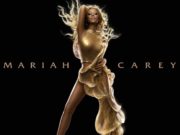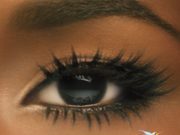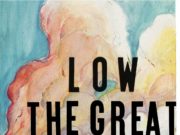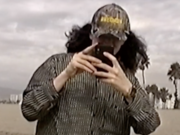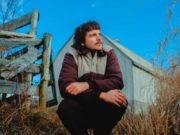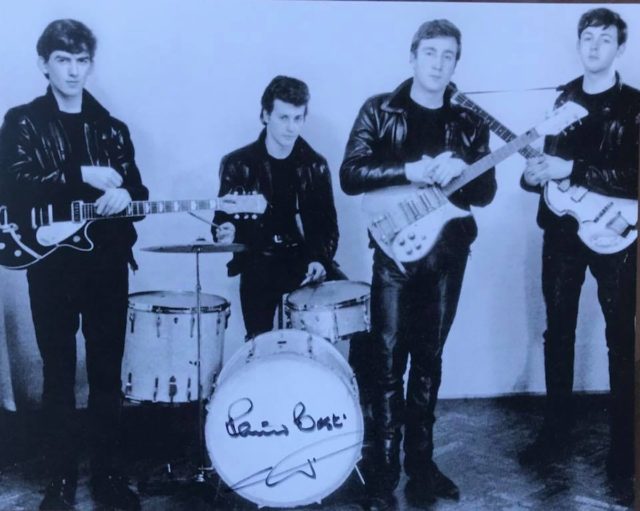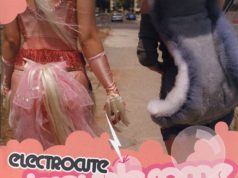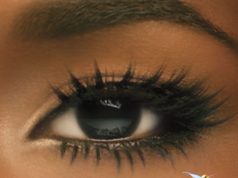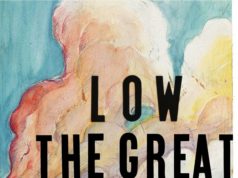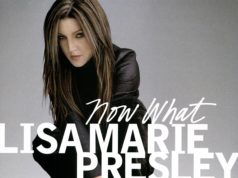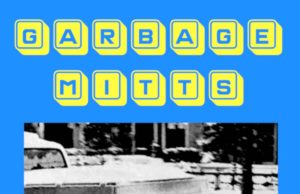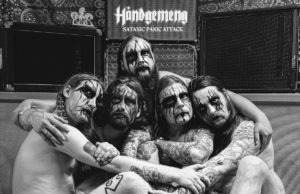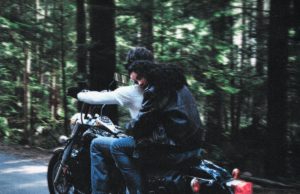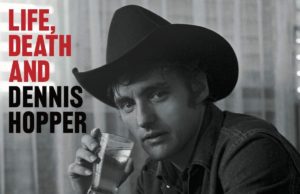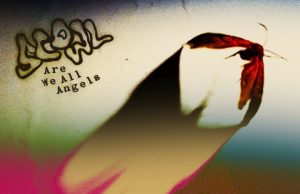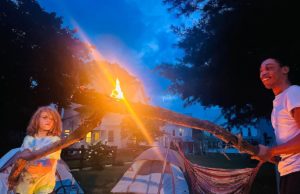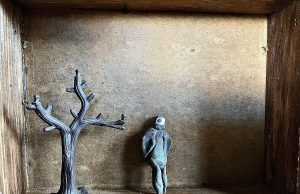 There are plenty of musical hotspots in this world — Seattle, Atlanta, Toronto, Montreal, New York, London, Nashville, Memphis, Berlin, Detroit, New Orleans, Los Angeles, San Francisco, Chicago, Boston and Philadelphia. When you say those names in a musical context, I’m guessing a musical style or a particular band comes to mind.
There are plenty of musical hotspots in this world — Seattle, Atlanta, Toronto, Montreal, New York, London, Nashville, Memphis, Berlin, Detroit, New Orleans, Los Angeles, San Francisco, Chicago, Boston and Philadelphia. When you say those names in a musical context, I’m guessing a musical style or a particular band comes to mind.
But where you get neat little stories is from the smaller towns, and the same-era bands from there. Like The Move and Black Sabbath both being from Birmingham, England, or The B-52’s and R.E.M. both being from Athens, GA.
Sometimes your favourite musicians even got their start in different local bands with other before-they-were-famous musicians. For instance: Back in 1969, Reggie Dwight, 22, was just beginning to transform into Elton John, and 19-year-old Roger Hodgson had just finished boarding school and wanted to be a rock star. He scored an audition with Island Records which led to him being paired up with Elton, guitarist Caleb Quaye and drummer Nigel Olsson. The band was called Argosy, and actually released a single.
Now, this band was just a one-off. Elton was trying to get his own thing going and was essentially just a session player on the single. He and Quaye had been in the pub band Bluesology together and Nigel Olsson would play with Elton for the bulk of the remainder of his career. But imagine if this band had worked — if Mr. Boyd had been a hit and the foursome all got along really well. What then? Thankfully for all concerned, the single flopped, Hodgson answered an ad in Melody Maker posted by Rick Davies, and the pair formed Supertramp. But imagine Supertramp with Elton in place of Davies. Or imagine Elton not as a solo artist, but instead as a co-songwriter with Hodgson. Where does that leave Bernie Taupin? By this point, Taupin and Elton had been staff writers for months at Dick James Music. They even penned a Eurovision song for Lulu. One hit single, and things would have certainly been different. So, I thought I’d investigate some similar cases:
Sweet Leaf for Aqualung
For two weeks in late 1968, Tony Iommi reluctantly left his band Earth for a new role in the established progressive blues-rock band Jethro Tull. He was replacing lead guitarist Mick Abrahams, who was dominant on the band’s debut album This Was. Iommi was with the band for their appearance in The Rolling Stones’ Rock & Roll Circus, miming Abraham’s parts during Song For Jeffrey. Iommi was supposedly impressed with Jethro frontman Ian Anderson’s all-business approach to running a band, but it just wasn’t for him. It wasn’t fun like Earth was. So he quit. Returning to Birmingham, he connected with bandmate Terry “Geezer” Butler and the two transformed Earth into Black Sabbath. There’s no sense in trying to imagine Sabbath without Iommi. It simply wouldn’t have happened. It’s quite unlikely John “Ozzy” Osbourne, Butler or Bill Ward would have become famous. But I envision Tull being quite similar to what it became with Martin Barre replacing Iommi. Barre wasn’t a songwriter. Anderson wrote everything, and I can’t imagine him allowing Iommi to contribute even though he was one of rock’s greatest riff writers. You gotta think he might have managed to slip one of them into a solo somewhere.
The Pompatus of Lido
Boz Scaggs was one of the co-founders of The Steve Miller Band. He contributed extensively to the group’s first two albums, before departing for a long — but less successful — solo career. Scaggs’ biggest hit didn’t come until six years later when he released Silk Degrees, featuring the huge singles Lido Shuffle and Lowdown. It’s fun to imagine a Steve Miller Band version of Lido Shuffle. I guess the album it would have been on would be Fly Like An Eagle, which was already a monster hit with its three singles — the title track, Rockin’ Me and Take The Money and Run. Along with FM-radio favourite Wild Mountain Honey, the addition of Lido Shuffle and Lowdown would have put it in Rumours territory.
…And Justice Sells… but Who’s Buying?
Would Metallica have been even bigger if they hadn’t kicked Dave Mustaine out of the band? Doubtful. They certainly wouldn’t have written Enter Sandman. Mustaine did contribute to some great early tracks on Metallia’s debut album Kill ‘Em All — The Four Horseman, Jump in the Fire and Metal Militia — and Megadeth are certainly popular, but I don’t see Metallica progressing into the chart-topper they became with Mustaine on board. I believe their success would have been on par with Megadeth.
John, Paul, George & Pete
I’d argue Ringo Starr is the third most critical member of The Beatles. I think they would have still had success if they had some other guitarist than George Harrison. Truthfully, they probably would have had a different bass player, as Paul McCartney likely would have been the lead guitarist had he not managed to convince John Lennon to let the teenage Harrison into the band. But if The Beatles had insisted on Pete Best being their drummer, a couple of things would have changed right away. First, producer George Martin would have replaced him on the recordings with a session drummer like he did on the album version of Love Me Do with Andy White. In fact, Martin never insisted they fire Best — he just said he’d not be using him on the recordings. There’s no way Best could have sung like Ringo did on early tracks like Boys, or later iconic ones like Yellow Submarine and With A Little Help From My Friends. And he was a far better drummer, of course. Never mind Best; there aren’t many drummers period who can do what Ringo does on Tomorrow Never Knows, Rain and She Said She Said. Imagine that: “She said…” CHA-CHA-CHA “…I know what it’s like to be dead.”
Ghost in the Soft Machine
For a while there it seemed like Andy Summers was going to make a name for himself by playing with more bands than Paul Shaffer or Jools Holland.
And then The Police happened, and now almost nothing else of his ongoing 60-year career is talked about. He started out as the guitarist in Zoot Money’s Big Roll Band, which evolved into Dantalian’s Chariot. When that band broke up, he joined The Animals for a little while in 1968. But before that, he was recruited to fill out the lineup of Soft Machine so they could have enough musicians to do a quick U.S. tour with Jimi Hendrix. The band’s debut album was recorded, but not out yet, and Summers would be fired before the end of the tour, and well before recording of the second album. He was cut at the insistence of singer-songwriter Kevin Ayers, who quit for a solo career anyway right after the tour. Soft Machine with the expert textures of Andy Summers would really have been something, especially on their third album — which proved to be the band’s most popular.
Tooling in the Name Of
Tool guitarist Adam Jones went to high school with Rage Against The Machine / Audioslave guitarist Tom Morello. They were even in a band together called Electric Sheep. According to Jones, the teens started around the same time, but Morello went away to college and came back with unmatchable skills. Tool debuted in 1990 and Rage the following year. Both bands have always been quartets, with Jones and Morello as sole guitarist. It’s difficult to imagine either of them with a two-guitar sound. Normally, I quite like the dynamics of two guitars — but in this case, I think both bands run the risk of becoming a wall of noise.
Mynah Birds, Major Talent
Before Neil Young moved to the U.S. and became a member of Buffalo Springfield, he was persuaded to join a fledgling Rolling Stones-like R&B group by his friend, bassist Bruce Palmer — eventually also of Buffalo Springfield. The Mynah Birds were a Toronto band funded by the Eaton family. Their lead singer was an American draft dodger named Ricky Matthews. He would eventually find fame (and infamy) as Rick “Super Freak” James. Young and James actually lived together briefly. The band cut a single and were offered a contract by Motown. But their manager “lost” the advance money and was fired. In retaliation, he ratted out James’ status as a U.S. Navy deserter. James was arrested by authorities and the band broke up — prompting Young and Palmer to head to California in search of Stephen Stills. It’s impossible to imagine a role for Young in James’ solo work — despite the fact that both men are essentially frontmen, funk is the one style Neil has never really attempted, thankfully. However, if their manager hadn’t been a total shyster, it seems like The Mynah Birds would have at least made an LP — probably with songs featuring Young/James co-writes. I envision them becoming something akin to Love. Here’s what they sounded like:
1952 Vincent Golden Brown Lightning
This may be an even stranger coupling. Hugh Cornwell, the original lead vocalist and lead guitarist of The Stranglers, and singer-songwriter and guitarist Richard Thompson were high-school classmates and even were in a band together in northwest London called Emil And The Detectives. Thompson’s dad was a guitar player (and Scotland Yard detective), so Cornwell played bass. Cornwell stayed in school, earning a bachelor’s degree in biochemistry and then, in the late ’60s, moved to Sweden to do postgraduate research at Lund University. There he started the band Johnny Sox. He returned to the U.K. in 1974 with Johnny Sox in tow and they eventually became The Stranglers. Thompson, meanwhile, co-founded Fairport Convention in 1967 when he was just 18 years old. I simply can’t make my brain combine the two men.
Shoplifters of the World Sell Sanctuary
Anyone who has seen the 2017 biopic England Is Mine, about the early years of Smiths frontman Steven Morrissey, knows he used to be in a band with The Cult guitarist Billy Duffy. The pair grew up in Manchester in the ’70s and were drawn together by a mutual love of New York underground music — Patti Smith, New York Dolls, Lou Reed, Wayne County & the Electric Chairs, etc. The two young men were part of a clique who would go into town, buy (and steal) records and hang out. Morrissey eventually showed Duffy some of his lyrics. Impressed, Duffy and Morrissey became friends and started going to gigs together. Duffy was 16 when he was invited to be the replacement guitarist for the local band Ed Banger & The Nosebleeds. In search of a new vocalist, Duffy cautiously suggested his friend Steve. With Morrissey up front, the band became known simply as The Nosebleeds, with Duffy and Morrissey taking the initiative to write and insist upon new material. Duffy played two gigs with the band before he got an offer he couldn’t refuse — going to London to play with the band Studio Sweethearts, who had a record deal and offered him regular wages. There’s really no imagining Morrissey as the lead vocalist of The Cult, but Duffy taking the role of Johnny Marr in The Smiths is an intriguing notion — one which probably would have happened.
• • •
Area Resident is an Ottawa-based journalist, recording artist, music collector and re-seller. Hear (and buy) his music on Bandcamp, email him HERE, follow him on Instagram and check him out on Discogs.



